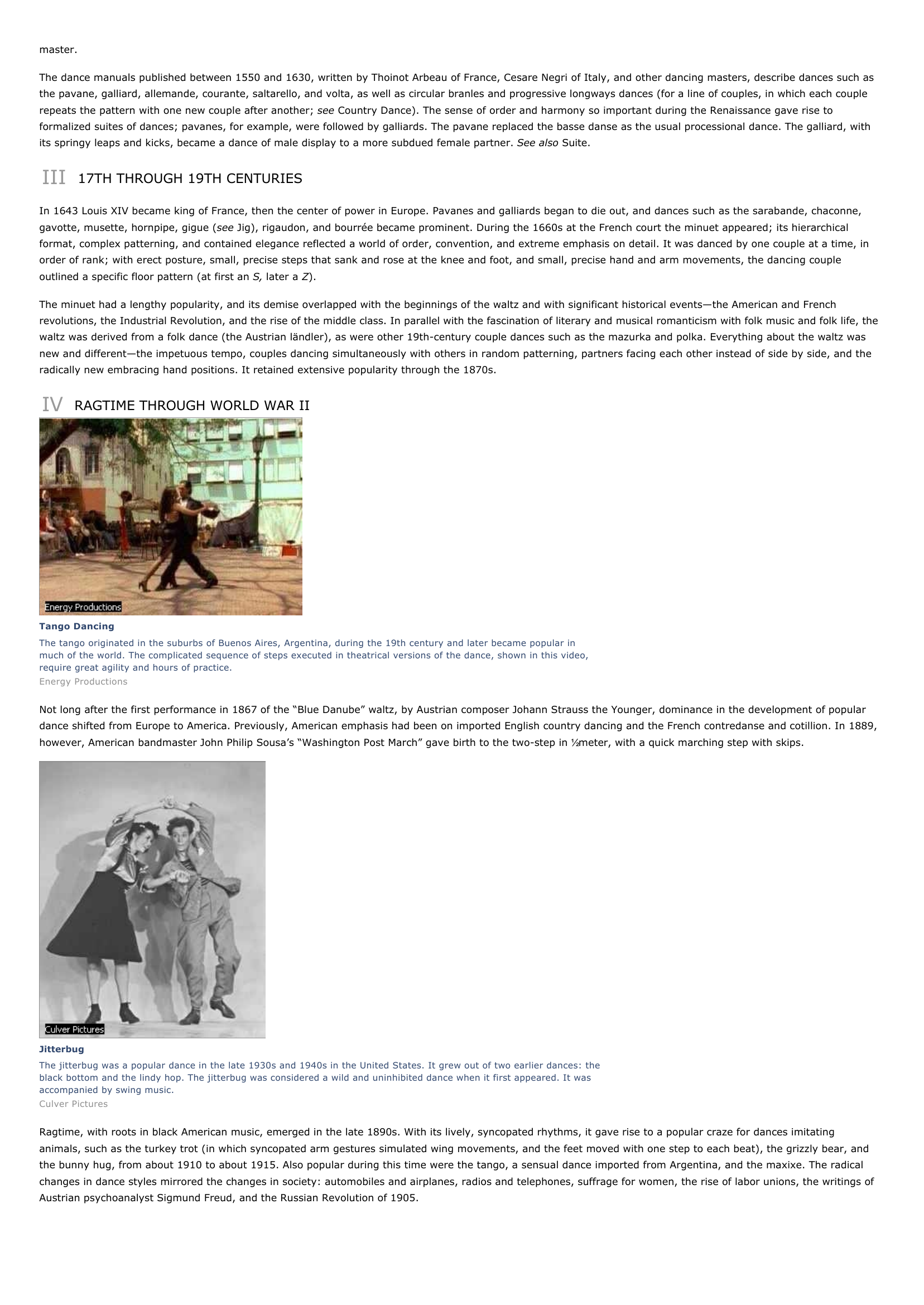Popular and Social Dance I INTRODUCTION The Cakewalk The cakewalk, a dance of African American origin, was intended to lampoon high-strutting whites at fancy dress balls.
Publié le 12/05/2013

Extrait du document
«
master.
The dance manuals published between 1550 and 1630, written by Thoinot Arbeau of France, Cesare Negri of Italy, and other dancing masters, describe dances such asthe pavane, galliard, allemande, courante, saltarello, and volta, as well as circular branles and progressive longways dances (for a line of couples, in which each couplerepeats the pattern with one new couple after another; see Country Dance).
The sense of order and harmony so important during the Renaissance gave rise to formalized suites of dances; pavanes, for example, were followed by galliards.
The pavane replaced the basse danse as the usual processional dance.
The galliard, withits springy leaps and kicks, became a dance of male display to a more subdued female partner.
See also Suite.
III 17TH THROUGH 19TH CENTURIES
In 1643 Louis XIV became king of France, then the center of power in Europe.
Pavanes and galliards began to die out, and dances such as the sarabande, chaconne,gavotte, musette, hornpipe, gigue ( see Jig), rigaudon, and bourrée became prominent.
During the 1660s at the French court the minuet appeared; its hierarchical format, complex patterning, and contained elegance reflected a world of order, convention, and extreme emphasis on detail.
It was danced by one couple at a time, inorder of rank; with erect posture, small, precise steps that sank and rose at the knee and foot, and small, precise hand and arm movements, the dancing coupleoutlined a specific floor pattern (at first an S, later a Z).
The minuet had a lengthy popularity, and its demise overlapped with the beginnings of the waltz and with significant historical events—the American and Frenchrevolutions, the Industrial Revolution, and the rise of the middle class.
In parallel with the fascination of literary and musical romanticism with folk music and folk life, thewaltz was derived from a folk dance (the Austrian ländler), as were other 19th-century couple dances such as the mazurka and polka.
Everything about the waltz wasnew and different—the impetuous tempo, couples dancing simultaneously with others in random patterning, partners facing each other instead of side by side, and theradically new embracing hand positions.
It retained extensive popularity through the 1870s.
IV RAGTIME THROUGH WORLD WAR II
Tango DancingThe tango originated in the suburbs of Buenos Aires, Argentina, during the 19th century and later became popular inmuch of the world.
The complicated sequence of steps executed in theatrical versions of the dance, shown in this video,require great agility and hours of practice.Energy Productions
Not long after the first performance in 1867 of the “Blue Danube” waltz, by Austrian composer Johann Strauss the Younger, dominance in the development of populardance shifted from Europe to America.
Previously, American emphasis had been on imported English country dancing and the French contredanse and cotillion.
In 1889,however, American bandmaster John Philip Sousa’s “Washington Post March” gave birth to the two-step in ½ meter, with a quick marching step with skips.
JitterbugThe jitterbug was a popular dance in the late 1930s and 1940s in the United States.
It grew out of two earlier dances: theblack bottom and the lindy hop.
The jitterbug was considered a wild and uninhibited dance when it first appeared.
It wasaccompanied by swing music.Culver Pictures
Ragtime, with roots in black American music, emerged in the late 1890s.
With its lively, syncopated rhythms, it gave rise to a popular craze for dances imitatinganimals, such as the turkey trot (in which syncopated arm gestures simulated wing movements, and the feet moved with one step to each beat), the grizzly bear, andthe bunny hug, from about 1910 to about 1915.
Also popular during this time were the tango, a sensual dance imported from Argentina, and the maxixe.
The radicalchanges in dance styles mirrored the changes in society: automobiles and airplanes, radios and telephones, suffrage for women, the rise of labor unions, the writings ofAustrian psychoanalyst Sigmund Freud, and the Russian Revolution of 1905..
»
↓↓↓ APERÇU DU DOCUMENT ↓↓↓
Liens utiles
- Musical I INTRODUCTION George Gershwin American pianist, songwriter, and composer George Gershwin was one of the most important figures in popular song in the 1920s and 1930s.
- Luciano PavarottiIINTRODUCTIONLuciano PavarottiRenowned Italian tenor Luciano Pavarotti was known for his mastery of the highest notes of a tenor's range and for hisjovial personality, which helped him earn a wide popular following.
- Popular Music I INTRODUCTION Satchmo Sings "Back O' Town Blues" One of the founders of instrumental jazz music, American Louis Armstrong, known as Satchmo, also profoundly influenced vocal jazz and popular song.
- American Music I INTRODUCTION American Music, the folk, popular, and classical music of the United States--created by American-born or American-trained composers, or originating in American culture, or written primarily for American audiences.
- Beyoncé, who was born the fourth of September nineteen-eighty-one in Texas, is an American author, compositor, singer and actress.











